| back to: index 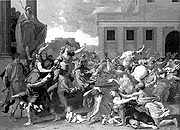
Rape of the Sabines
Nicholas Poussin, 1636-37
 Homage to Bleriot
Robert Delaunay, c. 1940
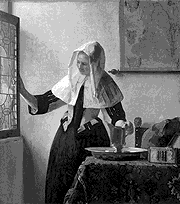
Young Woman with a Water Jug
Jan Vermeer, c. 1665

Landscape
Sesshu?, c. 1495, Japan
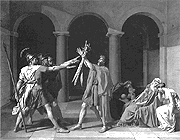
Oath of the Horatii
Jacques-Louis David, 1769
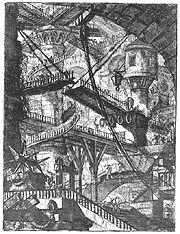
Drawbridge
G. B. Piranesi
drawing, 1760-61
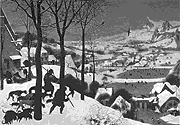
Hunters in the Snow
Jan Breughel the Elder, 1565
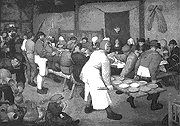
The Wedding Banquet
Jan Breughel the Elder, 1568
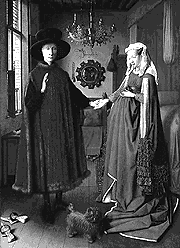
Arnolfini Wedding Portrait
Jan Van Eyck, 1434
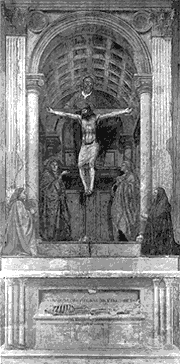
Trinity
Masaccio
Italian fresco painting, 1428

March Heath
Anselm Kiefer, 1984
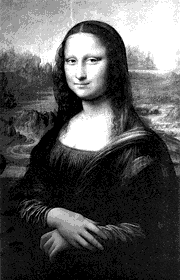
Mona Lisa
Leonardo da Vinci, 1503-06
|
Introduction
Images influence us and have for as long as art has existed
- The classroom we are sitting in was designed by those who understand how visual forms affect us.
- Colors such as blue or red have psychological influences on us. The color psychologist Faber Birren found that color affects us.
- Lines such as the vertical line of a column can influence the way we experience a place.
-Assumptions about art: "Talent" and "should look like something"
Art as Language
Semiotics, conceived of by Roman Jakobson, has 6 components:
1. Addressor (artist)
2. Addressee (viewer)
3. Message
4. Code
5. Medium of communication
6. Context
Form, Context, and Content in Art Evaluation
Form, Context, and Content play a role in our evaluation of a work of art.
In Poussin's Rape of the Sabine Women we see a narrative illustration of a story from Classical antiquity, a piece of propaganda for Louis the XIV, a collection of colors organized in an asymmetrical way, a Classical palette (primarily red, yellow, blue), and a violent scene. Each of these represent differing ways to evaluate the work. - Form: the work has an asymmetrical balance, a Classical palette, and mostly diagonal lines.
- Context: it is a painting done by Nicholas Poussin, in a Classical (Renaissance) way which helped to reinforce Louis XIV's claim to the Roman Emperorship.
- Content: a violent scene which is an illustration of a story from Classical antiquity.
In Robert Delaunay's Homage to Bleriot the same critical evaluation can be used even though it is dramatically different in its character. There still are many similarities. - Form: the work has an asymmetrical balance, a Classical palette, and mainly diagonal lines.
- Context: it is a painting done by Robert Delaunay in 1940 in an abstract way. Picasso was influential in the work of Delaunay and this work is highly abstracted.
- Content: a vibrant, colorful and lively painting that has no representational forms.
Assumptions About Art
-In the Western World we often evaluate a piece of work based on the artist's ability to reproduce the world in a fashion which reflects an illusion of reality. A person who is good at rendering the world in a realistic way often is regarded as a good artist. This particular way of evaluating artwork comes from the 18th and 19th Centuries when academies set objective standards for art. This type of evaluation undermines the importance of communication in a work. A work like Vermeer's Young Woman with a Water Jug is an example of an excellent work that uses an academic approach to painting.
-Outside of the Western World, there are other philosophical differences in how an artist communicates through art and how it is evaluated. For example, in China and Japan, a work of art is expected to add to our knowledge of a place, a person, etc. rather than simply reproducing it. There is an emphasis on the elements which make up the work and not the ability to make it seem"real." For example, in Sesshu's (?) Landscape, the influence of man is small reflecting a different cosmological philosophy. Man is a smal, but important, part of a larger universe. The artist has put emphasis on showing the medium (ink) by using it in a way that it can be easily identified. Like handwriting, the way the image is drawn is unique to the artist.
Vocabulary -
-Line: abstract idea representing the point where two planes meet. A good example of a work which employs line is Piranesi's Drawbridge drawing. There is an emphasis on diagonal lines which infer action.
-
-Value: lightness and darkness of an area or plane. In the Sesshu (?) Landscape we see the darks and lights very clearly.
-
-Balance, Design, or composition are all terms which refer to the organization of the elements in a work. Poussin's Rape of the Sabine Women has a quadrant composition and also is asymmetrical in design. it also uses a Classical palette which is made up of neutral tones and the Primary Colors.
-
-Color: Primary color (Red/Yellow/Blue) are the colors ahich cannot be mixed from any combination of colors.
-
-Secondary color(Orange/Green/Purple) are colors that can be mixed from any two Primary Colors.
-
-Color Complements are color opposites. they travel at drastically different wavelengths and our eye tends to exaggerate their intensity when both complements are present. Some complements are: Red/Green, Blue/Orange, and Purple/Yellow. The Arnolfini Wedding Portrait by Van Eyck uses this color effect.
-
-Genre Painting is the use of common or everyday scenes in a painting. Jan Breughel's Wedding Banquet and Hunters in the Snow.
Jacques-Louis David's Oath of the Horatii
-Line is used to communicate order, permanence, and authority. Other elements are used to communicate the illusion of space. These are commonly referred to as conventions. In this painting we respond to the subject, not the medium used (oil on canvas).
Conventions
- -Conventions are formulas used by artists in the creation of a work. They allow other artists to recreate effects and characterisics used by other artists.
- -Halos are a convention to identify an important person. Used on saints (holy), blue robe on Mary (color symbolized heaven). An example of a work that has halos on figures is Holy Trinity by Masaccio.
-
-Linear Perspective is a mathematical system for organizing space in a convincing way. It is used in Piranesi's Drawbridge drawing, Holy Trinity by Masaccio, The Arnolfini Wedding Portrait by Van Eyck, and Anselm Kiefer's March Heath.
-
-Aerial (Atmospheric) Perspective is a process that changes value/color to indicate depth. It is used in the background of the Mona Lisa by Leonardo da Vinci.
-
Chiaroscuro is the use of light and dark to indicate volume in a form. It is also shown in the Mona Lisa by Leonardo da Vinci. it also uses Sfumato (meaning vanished in smoke), a process that gives an atmospheric softness to a painting.
The Good, the Bad, the Ugly
-Art has been used to create political image and sway the opinion of many. Louis XIV (Sun King) established the Royal Academy of Painting and Sculpture as a way to influence the populace and support his claim as "Roman" Emperor. The Academy was the first school of art and had great influence in the art world when it was established. The school taught from a Classical perspective which created associations to the Roman Empire.
-Dutch painting from the same time focused on everyday themes and items. This was a style directed at the "middle class" of 17th Century Netherlands. Unlike high Classical painting, Dutch painting used everyday people and scenes (genre painting) as subject matter.
Making Amends
-Western art has unfairly categorized outside art using "social Darwinism" to elevate the art of the West and taint the work of other cultures. Words such as "primitive" have unfairly characterized some excellent art as a stage of development toward Western art (as if it were the ultimate goal). It is important to understand that excellence in art exists in all cultures and periods. We must look further into its background to understand the real value of the art in its cultural context.
next study guide: Chapter 1
|
|
|
